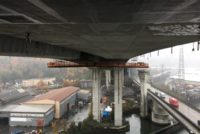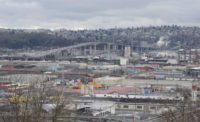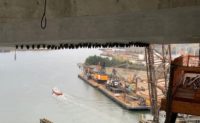Seattle is already dealing with concrete cracking on the now-closed, six-lane West Seattle High-Rise Bridge, and now faces needed crack repair on the West Seattle Low Bridge, also known as the Spokane Street Swing Bridge.
The two-lane concrete swing bridge opened in 1991 with internal post-tensioned steel support cables, similar to the High-Rise Bridge. It was designed to move over time in response to traffic, temperature conditions or seismic events. But cracks discovered on the Low Bridge are now being “closely monitored and tested to ensure that they do not affect the bridge’s structural integrity,” the Seattle Dept. of Transportation (SDOT) said in a statement.
The bridge, with two 7,000-ton movable sides using a hydraulic mechanism to swing open for ship passage, is currently open only to emergency vehicles and permitted workers during normal business hours so as to not become a traffic chokepoint during the High-Rise Bridge closure.
The cracks run a few inches deep and aren’t showing the progression rates that led to March’s emergency closure of the High-Rise bridge. “We are confident that the Low Bridge’s crack depth, growth patterns and type do not indicate that the bridge is unsafe for live traffic,” SDOT says. “We have no reason to think that the Low Bridge is in any imminent risk, but because the bridge now plays such an over-sized role in our transportation system, we have developed a forward-thinking plan to strengthen it further and have been taking numerous precautionary steps to monitor and care for this bridge since the closure of the High-Rise Bridge.”
The cracks, first discovered in 2019, now undergo regular in-person inspections. “Things that we are doing right now and will continue to do are weekly inspections and monitoring,” says Matt Donahue, SDOT roadway structures director.
When SDOT installed an intelligent monitoring system on the High-Rise Bridge with BDI, they also added the same type of system on the Low Bridge to collect real-time data, allowing traffic and thermal variations to be analyzed.
Testing has shown that, unlike the High-Rise Bridge, cracks do not extend through the Low Bridge girder walls. SDOT used a heavy truck to travel the bridge to monitor all instrumentation and examine the bridge’s response, confirming the need to lower the speed limit from 30 mph to 25 mph to reduce vibrations.
The city plans to use steel cables to tension the bridge, perform maintenance on the center-lock system to reduce stress during the transition between the two halves of the bridge, and install carbon-fiber wrapping, calling that step a “purely precautionary measure.”






Post a comment to this article
Report Abusive Comment